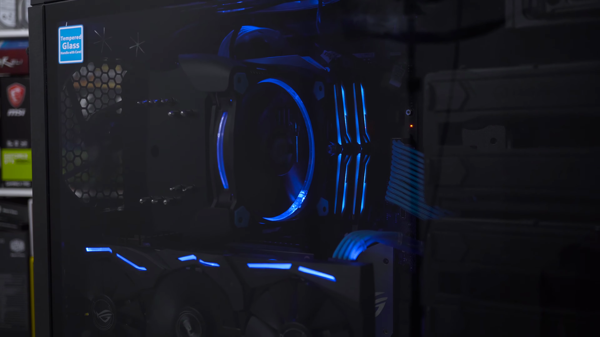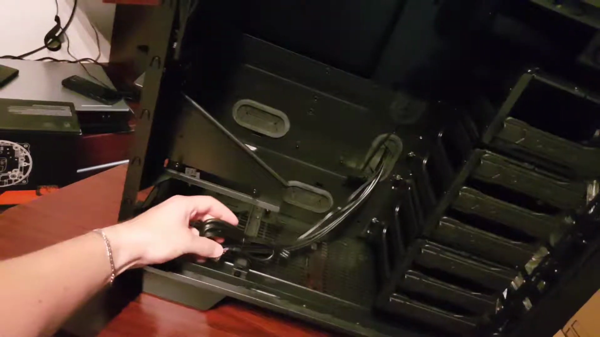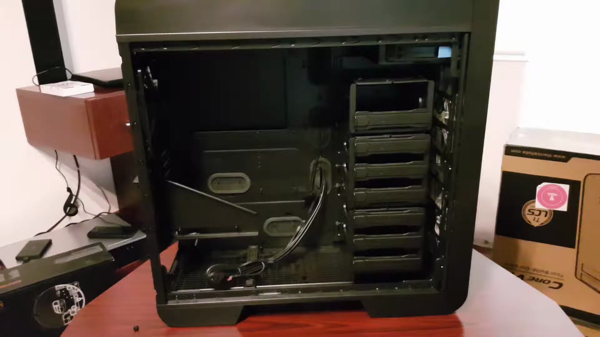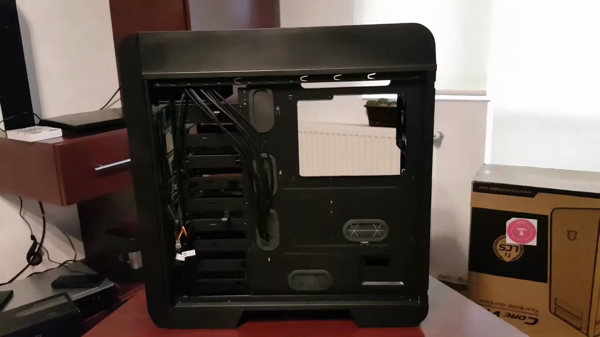Note: As an Amazon Associate I earn from qualifying purchases.
Review: Trying out the Thermaltake Core V71 Tempered Glass E-ATX Full Tower Case (2024)
Introduction
I recently put together a new PC using the Thermaltake Core V71 Tempered Glass Edition E-ATX Full Tower. From building to performance, I’ve gathered some thoughts on it below.
Specifications
| Property | Value | Property | Value |
|---|---|---|---|
| Brand | Thermaltake | Motherboard Compatability | ATX |
| Case Type | Full Tower | Recommended Uses For Product | Business |
| Color | View 71 TG | Material | Tempered Glass |
| Cooling Method | Water, Air | Model Name | CA-1B6-00F1WN-04 |
| Item Weight | 30 Pounds | Product Dimensions | 22”D x 9.1”W x 23”H |
Photos
Click on photos to enlarge them:
Prices
Check prices of the Thermaltake Core V71 Tempered Glass Full Tower Case on:
Design and Build Quality

The Thermaltake Core V71 Full Tower Case comes in a large size, featuring a 4mm thick tempered glass side panel. Its design emphasizes durability and caters to users seeking ample space for complex configurations. This case boasts a sleek appearance, as well as playing a role in sound dampening.
Here’s a description of the build features I find most useful:
Material Quality: The SPCC steel gives the case a sturdy feeling without making it overly heavy. There’s a certain reassurance in the solidity of the construction.
Aesthetic Appeal: The 4mm tempered glass side panel is a nice visual touch that also makes it simple to inspect your components. Plus, the blue LED lighting adds a subtle but cool gaming vibe.
Noise Control: The tempered glass effectively reduces noise produced by the fans. This is unexpected given their number.
While the overall quality is good, there are some issues to note:
The front panel detaches too easily for my preference. Reattaching it is simple, but I believe a more snug fit could have been engineered.
Moving the case with detachable top and front panels isn’t as simple as expected due to their design. No clear handles are provided for safer transportation.
I appreciate the consideration given to motherboard sizes up to E-ATX and the addition of a riser GPU support bracket. This feature is useful for preventing GPU sag and allowing a vertical display of the graphics card. However, it may not be suitable for high-power GPUs due to potential airflow constraints.
The case boasts ten drive bays, a useful feature for expanding storage capacity. This aspect is particularly appealing to individuals who deal with large files and multiple projects. The pre-installed fans provide robust airflow but are somewhat louder than desired. A built-in I/O port enables control over LED and fan speed.
In summary, the Thermaltake Core V71 case meets my expectations for a full tower build with its ample space and versatile design. Its robust construction instills confidence in its long-term durability. Although it has minor issues with practicality, particularly moving the case, these do not significantly impact the overall positive experience. For those seeking a case that supports large builds and various configurations, the Core V71 is a solid pick despite its minor drawbacks.
Cooling and Ventilation

In my experience with the Thermaltake Core V71 Tempered Glass Edition, the cooling and ventilation are important features to address. The case includes three 200mm LED fans and one 140mm rear fan, providing ample airflow for effective cooling. This setup is ideal for most configurations, ensuring good temperature management. While I value the substantial interior space for enhanced circulation, I have reservations about the static pressure capabilities of the fans. Larger fans often produce less pressure which could be a disadvantage for components that need more focused airflow.
Here’s a description of the cooling process I observed:
Pros:
This product comes with a sufficient number of pre-installed fans for effective cooling right out of the box.
The case supports water cooling options readily, catering both to AIO solutions or custom loops.
Low fan speeds on the large fans offer a noise-efficient environment, which is crucial for those who prefer a quiet workspace.
Vertical GPU support simplifies the load on the motherboard. However, it may not ensure the best GPU cooling.
Cons:
Larger fans don’t have the highest static pressure, which may not suit all components.
Fan and light adjustments are beneficial, but they don’t support PWM regulation for improved thermal precision.
The larger size of computer fans comes with a notable size advantage, allowing for superior balance between airflow and noise levels. This is particularly beneficial when dealing with components such as my 5900X and RX6900X, which maintain cool temperatures even during heavy usage. Nevertheless, optimizing airflow is crucial since the pre-installed fan controller only provides basic adjustments without connecting to the motherboard’s more sophisticated fan control systems. Leveraging this size advantage effectively can lead to improved system performance and longevity.
Admittedly, I was disappointed by the initial lack of precise control over the fans. Ideally, integrating them with the motherboard would provide a more dynamic cooling solution, adjusting in real-time to the system’s requirements.
Water cooling enthusiasts will appreciate the V71’s roomy interior for installing large radiators. This case is a good option for those planning to set up a comprehensive liquid cooling system as an upgrade.**
Under the “more is better” philosophy, the Thermaltake Core V71 case excels in delivering effective cooling through substantial airflow and quiet operation. Adhering to this principle, its design prioritizes ample ventilation space, ensuring that users benefit from increased cooling capacity. While some may argue that a standard configuration doesn’t fully cater to their preferences, particularly those advocating for hands-on thermal management, the Thermaltake Core V71 lays a strong groundwork for both air and liquid cooling methods, providing a solid foundation for those who seek maximum cooling performance.
Expansion and Compatibility

In my search for a full tower chassis to house my hardware collection, I came across the Thermaltake Core V71. This model boasts impressive expansion capabilities and versatility in terms of compatibility.
Here’s a description of the expansion’s new features:
Motherboard Compatibility: Fits a wide range from Mini ITX to E-ATX, so I had no issues installing my E-ATX board.
Two Drive Bays, one for each 5.25” size and eight for 3.5” or 2.5”, provide sufficient space for storage expansion.
The case offers eight Expansion Slots, enabling support for multiple GPUs or other PCI-e cards.
During my setup, I noticed the riser GPU support bracket. It’s useful for vertically mounting GPUs and helps prevent sagging. The clean look is an added bonus. However, with thicker, more powerful cards, airflow can be an issue due to the limited space between the card and glass panel.
In my experience, it’s crucial to note that the pre-installed fans came with varying degrees of functionality. I was initially pleased not to have to purchase additional fans, but I soon discovered that the set of three 200mm fans and one 140mm fan lacked temperature control capabilities. Instead, they connected to a built-in controller rather than the motherboard. This arrangement poses potential issues for users employing warmer components or those engaging in overclocking, as fan speeds would not adjust automatically based on system heat levels – a feature commonly referred to as temperature-controlled fan operation.
The 10 drive bays are beneficial as they allow me to install multiple hard drives. However, the front/top USB ports only supporting USB 3.0 Gen 1 and lack of USB-C may seem restrictive for users desiring modern I/O technology.
In the compatibility aspect, the Thermaltake Core V71 impresses. It supports extensive air cooling and water cooling with radiator size of up to 420mm, allowing ample space for either method. This feature ensures that I face no compatibility limitations when upgrading or repurposing this case in the future.
What it all boils down to is that the Core V71 presents an advantageous unity of compatibility and expansion, suitable for both workstations and gaming setups. While it does fall short in some modern conveniences, those drawbacks are outweighed by its profound flexibility, especially for users like me needing abundant storage and diverse motherboard support.
Overall Experience and Verdict

After spending ample time with the Thermaltake Core V71 Tempered Glass Edition E-ATX Full Tower, I’ve come to recognize its merits while acknowledging its minor drawbacks. Here’s a straightforward assessment:
Pros:
Large interior for users requiring multiple drive bays and expansion slots.
The monitor has a robust construction with a tempered glass cover, enhancing its modern appearance while reducing noise.
Superior cooling: This component boasts impressive cooling capacity thanks to its large 200mm fans that ensure ample airflow.
Control fan speed and LED lighting with a single click.
This component is compatible with various motherboard types, including E-ATX, offering users significant flexibility in their choices.
Cons:
Vertical GPU support can be appealing, but may not function optimally with larger, high-end graphics cards.
The pre-installed fans in this system are controlled using buttons instead of being managed through the motherboard based on temperature.
Design aspects might create issues for transportation and may not cater to all users’ requirements.
In terms of storage and cooling, the Core V71 impresses me. I need room for up to ten drives, which this case offers in abundance. With growing game files and media libraries, this is particularly beneficial. The cooling system works well, keeping temperatures reasonable even under heavy usage. It’s convenient to manually adjust fan speeds without using software, although I prefer temperature-controlled fan settings that integrate with the motherboard.
Speaking of motherboards, this case can support various sizes from Mini ITX to E-ATX. It ensures investment for future upgrades or system overhauls without complications.
However, users considering mounting their GPU vertically in a case should exercise caution. Although the case may promote this option, larger and heavier modern GPUs could struggle with adequate cooling against the glass panel. This is important to note if you intend to display your advanced graphics card.
Transporting the case requires care due to its easily detachable front and top panels, which can pose a risk of accidents. I recommend having side panels that are hinged or more securely attached to minimize the chance of them falling during removal.
Despite concerns about certain features, the case offers more advantages than disadvantages. Its robust design, tempered glass, and cooling efficiency make it both visually appealing and highly effective. Although it lacks modern conveniences such as system-integrated fan control and USB-C ports, its strengths outweigh these absences.
Concluding, the Thermaltake Core V71 offers impressive features. This case combines style and power, making it suitable for diverse builds. Although it may include minor drawbacks, its benefits make it an excellent option for dedicated PC builders – whether they are gamers or professionals.




